Between ice cream and longer days, summer is here. At this time of year, open information can become our best ally to plan getaways, know schedules of the bathing areas in our community or even know the state of traffic on roads that take us to our next destination.
Whether you're on the move or at home resting, you can find a wide variety of datasets and apps on the datos.gob.es portal that can transform the way you live and enjoy the summer. In addition, if you want to take advantage of the summer season to train, we also have resources for you.
Training, rest or adventure, in this post, we offer you some of the resources that can be useful this summer.
An opportunity to learn: courses and cultural applications
Are you thinking of making a change in your professional career? Or would you like to improve in a discipline? Data science is one of the most in-demand skills for companies and artificial intelligence offers new opportunities every day to apply it in our day-to-day lives.
To understand both disciplines well and be up to date with their development, you can take advantage of the summer to train in programming, data visualization or even generative AI. In this post, which we published at the beginning of summer, you have a list of proposals, you are still in time to sign up for some!
If you already have some knowledge, we advise you to review our step-by-step exercises. In each of them you will find the code reproducible and fully documented, so you can replicate it at your own pace. In this infographic we show you several examples, divided by themes and level of difficulty. A practical way to test your technical skills and learn about innovative tools and technologies.
If instead of data science, you want to take advantage of it to gain more cultural knowledge, we also have options for you. First of all, we recommend this dataset on the cultural agenda of events in the Basque Country to discover festivals, concerts and other cultural activities. Another interesting dataset is that of tourist information offices in Tenerife where they will inform you how to plan cultural itineraries. And this application will accompany you on a tour of Castilla y León through a gamified map to identify tourist places of interest.
Plan your perfect getaway: datasets for tourism and vacations
Some of the open datasets you can find on datos.gob.es are the basis for creating applications that can be very useful for travel. We are talking, for example, about the dataset of campsites in Navarre that provides updated data on active tourism camps, including information on services, location and capacity. In this same autonomous community, this dataset on restaurants and cafeterias may be useful to you.
On the other hand, this dataset on the supply of tourist accommodation in Aragon presents a complete catalogue of hotels, inns and hostels classified by category, allowing travellers to make informed decisions according to their budget and preferences.
Another interesting resource is this dataset published by the National Institute of Statistics, which you can also find federated in datos.gob.es on trips, overnight stays, average duration and expenditure per trip. Thanks to this dataset, you can get an idea of how people travel and take it as a reference to plan your trip.
Enjoy the Water: Open Datasets for Water Activities
Access to information about beaches and bathing areas is essential for a safe and pleasant summer. The Bizkaia beach dataset provides detailed information on the characteristics of each beach, including available services, accessibility and water conditions. Similarly, this dataset of bathing areas in the Community of Madrid provides data on safe and controlled aquatic spaces in the region.
If you want a more general view, this application developed by the Ministry for Ecological Transition and Demographic Challenge (MITECO) with open data offers a national visualization of beaches at the national level. More recently, RTVE's data team has developed this Great Map of Spain's beaches that includes more than 3,500 destinations with specific information.
For lovers of water sports and sailing, tide prediction datasets for both Galicia and the Basque Country offer crucial information for planning activities at sea. This data allows boaters, surfers and fishermen to optimize their activities according to ocean conditions.
Smart mobility: datasets for hassle-free travel
It is not news that mobility during these months is even greater than in the rest of the year. Datasets on traffic conditions in Barcelona and the roads in Navarra provide real-time information that helps travellers avoid congestion and plan efficient routes. This information is especially valuable during periods of increased summer mobility, when roads experience a significant increase in traffic.
The applications that provide information on the price of fuel at the different Spanish petrol stations are among the most consulted on our portal throughout the year, but in summer their popularity skyrockets even more. They are interesting because they allow you to locate the service stations with the most competitive prices, optimizing the travel budget. This information can also be found in regularly updated datasets and is especially useful for long trips and route planning.
The future of open data in tourism
The convergence of open data, mobile technology and artificial intelligence is creating new opportunities to personalize and enhance the tourism experience. The datasets and resources available in datos.gob.es not only provide current information, but also serve as a basis for the development of innovative solutions that can anticipate needs, optimize resources, and create more satisfying experiences for travelers.
From route planning to selecting accommodations or finding cultural activities, these datasets and apps empower citizens and are a useful resource to maximize the enjoyment of this time of year. This summer, before you pack your bags, it's worth exploring the possibilities offered by open data.
The Aporta Challenges are awards for new ideas and prototypes that, making use of open data, lead to efficiency improvements in a specific sector of activity. In this section you will find infographics with information about the different editions carried out.
I Aporta challenge: The value of the data for the Administration
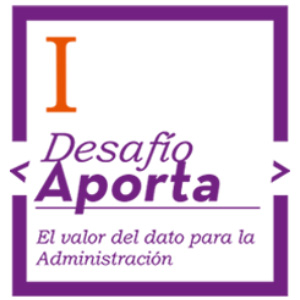 |
II Aporta Challenge: The value of data to the agri-food, forestry and rural sector
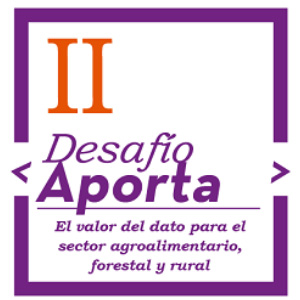 |
III Aporta challenge: The value of data in digital education
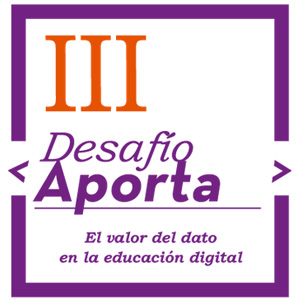 |
IV Aporta Challange: The value of data for health and well-being of citizens
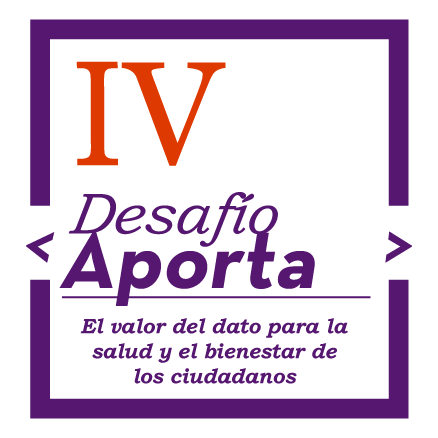 |
The pandemic that originated last year has brought about a significant change in the way we see the world and how we relate to it. As far as the education sector is concerned, students and teachers at all levels have been forced to change the face-to-face teaching and learning methodology for a telematic system.
In this context, within the framework of the Aporta Initiative, the study "Data-based educational technology to improve learning in the classroom and at home", by José Luis Marín, has been developed. This report offers several keys to reflect on the new challenges posed by this situation, which can be turned into opportunities if we manage to introduce changes that promote the improvement of the teaching-learning process beyond simply replacing face-to-face classes with online training.
The importance of data to improve the education sector
Through innovative educational technology based on data and artificial intelligence, some of the challenges facing the education system can be addressed. For this report, 4 of these challenges have been selected:
· Non-presential supervision of assessment tests: monitoring and surveillance of evaluative tests through telematic resources.
· Identification of behavioral or attention problems: alerting teachers to activities and behaviors that indicate attention, motivation or behavioral problems.
· Personalized and more attractive training programs: adaptation of learning routes and pace of students' learning.
· Improved performance on standardized tests: use of online learning platforms to improve results on standardized tests, to reinforce mastery of a particular subject, and to achieve fairer and more equitable assessment.
To address each of these four challenges, a simple structure divided into three sections is proposed:
1. Description of the problem, which allows us to put the challenge in context.
2. Analysis of some of the approaches based on the use of data and artificial intelligence that are used to offer a technological solution to the challenge in question.
3. Examples of relevant or highly innovative solutions or experiences.
The report also highlights the enormous complexity involved in this type of issues, so they should be approached with caution to avoid negative consequences on individuals, such as cybersecurity issues, invasion of privacy or risk of exclusion of some groups, among others. To this end, the document ends with a series of conclusions that converge in the idea that the best way to generate better results for all students, alleviating inequalities, is to combine excellent teachers and excellent technology that enhances their capabilities. In this process, open data can play an even more relevant role in improving the state of the art in educational technology and ensuring more widespread access to certain innovations that are largely based on machine learning or artificial intelligence technologies.
In this video, the author tells us more about the report:
Infomediary activity is not classified as such in the CNAE. Therefore, the census of companies must be updated through indirect and ad hoc actions. Periodically, the National Observatory of Telecommunications and the Information Society (ONTSI) analyzes the state of this sector and collects the results in a report, which this year reaches its fifth edition.
Under the title "From Infomediary Sector to Economy Data. Characterization of the Infomediate Sector", this year's report starts from a new approach, more aligned with the European Union's vision. The document highlights that the infomediate sector is evolving towards the data economy, and takes as a reference the words of the European Commission, which defines "data companies" as "organizations whose main activity is to produce products, services and technologies related to data".
A sustainable sector in continuous growth
This year's report shows us that we are facing a sector that does not stop growing in a sustainable way. 708 companies have been identified, 32% more than in 2016. It is worth noting that the businesses that are created around this activity last over time, since 63.7% of the companies analyzed are more than 10 years old. The sector is mainly concentrated in Madrid, where more than 50% of the companies are located. It is followed by Catalonia, with 18.4%.
In recent years there has been an evolution towards businesses centred on digital technologies: the most recent companies are mainly in the field of programming and IT consultancy and information services.
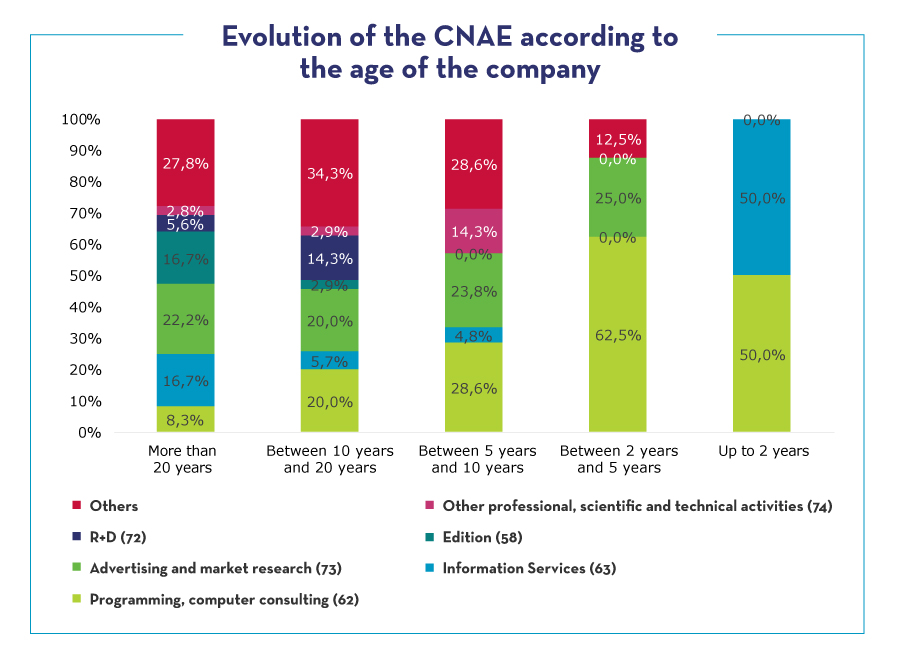
73.5% of the companies carry out more than one infomediaries activity, although the one that attracts more business in data analysis and/or visualization.

Almost 50% of these companies are micro-enterprises (with less than 10 employees) and only 6% have more than 250 employees. The turnover of the sector, however, is not negligible, estimated to reach 1,987 million euros in 2018, 15.4% more than in 2015. Of this volume, 718 million come from the reuse of information.
With regard to employment, in recent years there has been significant growth. The sector employs between 14,000 and 16,000 people, 14.3% more than in 2016. If we focus only on employees linked to data reuse, the growth is even more spectacular, 61.5%, reaching 7,700-8,400 workers.
Traditionally, the distribution of employment by gender in the infomediate sector has been equal (49.9% women and 50.1% men). However, the progressive introduction of digital technologies is breaking this parity in favor of men. Newer (and more technological) companies have many more men than women on their staff.
1 in 5 companies uses data from public sources
More than 80% of the companies analyzed use data from public sources to develop these services, which are combined with private data in 69.9% of the cases. The most demanded public information belongs to the fields of trade, environment, economy and demography. They mainly access this data in non-proprietary structured formats (csv, xml), although it is worth noting that there are still many suppliers that provide their data without structure (pdf, jpg), making it difficult to process automatically.
When asked about the data they most miss, the companies surveyed indicated that they would like to have more data on weather, real-time transport, tourism, demographics (with information disaggregated at the level of census sections), justice at the regional and local level, the public sector, the economy and the treasury.
These are just some of the report's conclusions, but there are many more. You can download the full report and its presentation below.
From its origins, the open data movement has been focused on opening up public sector data, and even the original statement of open data principles itself refers only to data from public administrations (open government data - OGD). However, this perception has evolved and today it is more common to speak of open data in a more general scope that includes all sectors, as demonstrated for example by the declaration of open data principles promoted more recently by the Open Data Charter, the wording of which is perfectly applicable to any sector.
On the other hand, while we now have a more than respectable and valuable amount of data available in open format from government, there are also some limitations with regard to governance and sustainability models for public data which, together with the remaining challenges of digital transformation in the sector, are to some extent limiting the ultimate availability of data. Data lifecycle management, technical and legal issues, adapting the skills of public employees or growing concerns about potential privacy issues are some of the barriers that public administrations have to face when trying to take their open data projects to the next level.
In this context, other data-producing sectors are also emerging as complementary sources to the hundreds of open data catalogues that governments have been publishing in recent years. These new data come from other publishers outside the public sector - such as the private sector, academia or the so-called third sector - all of them driven by different motivations and by the potential benefits associated with social reputation, innovation or attracting talent, among others. Even citizens themselves have now become a broad source of data, albeit sometimes unwittingly.
Thanks to this greater variety of data producers, the possibilities of enriching information by combining the different sources now available are increasing, but, at the same time, there is also a new need to improve coordination and integration between all parties in order to enable more efficient production and reuse of data and thus obtain the expected improvements in the social, economic and scientific spheres. The current challenge is therefore to find new models and collaborative relationships between the different parties that provide an adequate response to the existing challenges in achieving better management and availability of data, ultimately benefiting all parties and facilitating its reuse to a greater extent.
In order to get a more complete picture of the situation and to understand in more detail who these new data-producing sectors are, what their motivations are and what new models of collaboration are emerging between them, this report is divided into two parts:
![]()
In the first part of the report we will take a look at the different data producing sectors - leaving the public sector aside for a moment - and the alternative data sources they offer us, showing their motivations, their particularities and several examples.
![]()
In the second part of the report we will focus on analysing what models of collaboration can emerge between the public sector and other sectors to create joint actions to improve the governance, availability and ultimate re-use of data, showing again the differences and similarities between each of them and different examples of how they have been put into practice so far.
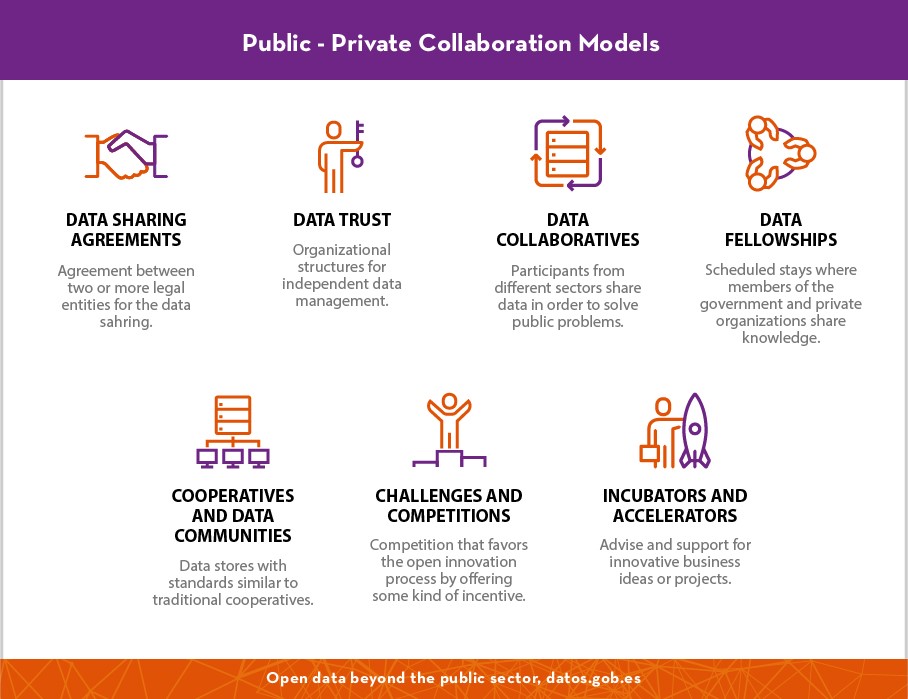
From the experimental vision of contests and competitions, to the purely entrepreneurial objective linked to the launch of incubators. From the models related to the legal responsibility point of view of data trusts, to the participative models of data collaboratives. From the actions with a more formative perspective of data fellowships, to the proposals aimed at empowering data cooperatives. All of them are possible models, some of them in a preliminary phase of consolidation but others more tested and refined, that can be more easily adopted. Let's discover them in this report and see how they can be put into practice in different contexts.
The data economy in the European Union exceeded € 375,000 M in 2018, with a growth close to 12% compared to 2017, and it is expected to continue growing to € 555,000 M in 2025. Then, it will reach 4% of the GDP of the EU27.
Given this situation, it is not surprising that an increasing number of companies are emerging in the field of data-based businesses. Starting a new business is not always easy. We need resources, knowledge of the business environment, contacts, a suitable team ... For that reason, it is important to know a series of public and private programs and initiatives that seek to help those braves who want to start their business.
The “Guide to accelerate data-based businesses”, carried out by the Digital Transformation expert Jose Luis Marín, collects a set of useful recommendations aimed at entrepreneurs and start-ups who want to access existing resources to boost and finance the development and launch of products and services that create value from the reuse of public or private data.
The guide is structured in 3 parts:
- In the first part, an introduction is developed that offers context about the growing market of products and services based on the use and reuse of public or private data. This explains growth forecasts and areas of greatest interest, such as artificial intelligence or smart city solutions.
- The second part provides a series of recommendations to help select the most appropriate resources to start up a business. For this, the different current mechanisms are explained: accelerators, incubators, public subsidies and private investments. The factors to be considered when filling out an application to access these resources are also explained.
- Finally, the third part collects some examples of concrete, public and private resources that entrepreneurs and start-ups can use to boost their projects.
You can access the report and other materials through the following links:
Open data is one of the key elements of smart cities. The collection of information, its analysis and its use make possible to address many of the challenges facing cities today, such as the creation of public services that respond to a growing population.
Among all the open datasets that are published related to cities, real-time data provides multiple advantages. Knowing the situation of our cities in real time can serve to make decisions and improve efficiency in urban mobility, energy management or environmental conditions, among other aspects.
In this context, the report "Open data in real time: use cases for smart cities" seeks to boost the opening of this type of data showing the advantages of its use. The report analyses the relationship between open data and smart cities, and shows a series of datasets that local entities should publish in real time, according to the report “Open Data 2019 - 40 datasets to be published by Local Entities”, elaborated by the FEMP (Spanish Federation of Municipalities and Provinces). These data sets belong to the fields of transport and mobility - public car park, public bicycles, traffic, public transport - and the environment - air quality and noise pollution.
Each dataset has been analysed highlighting some use cases and reuse examples, paying special attention to the positive impact they have on citizens. The technologies involved in its deployment, the stakeholders or future challenges, among other factors, have also been addressed.
The conclusions of the analysis are collected in each of the files that you can see below:
Datasets
You can also download the full report and other additional materials using the following links:
In the current context of digital transformation, all sectors are adapting to respond to the efficiency and agility improvement needs that society demands today. One of the areas where this change is most necessary is the agricultural and forestry sector.
The growth of the world population, climate change, or the depopulation of rural areas, something of particular concern in the specific case of Spain, make a paradigm shift necessary: a higher quantity of food must be generated, more quickly and sustainable with the environment.
To deepen this problem and its possible solutions, from the Aporta Initiative we have prepared the report “How open data can boost the agricultural and forestry sector”. The objective of the report is to promote the use of open data in the process of digital transformation of the agricultural and forestry sectors. Additionally, the report also focuses on water management as an element of great importance in the value chain.
The report is structured as follows:
- The first part begins with the analysis of the role that digital transformation is playing in solving the main challenges facing the agricultural and forestry sectors, highlighting the open data contribution as part of this process.
- In the second part, a series of repositories are compiled to find open data sets potentially useful to support digital transformation in these sectors.
- For the third part of the report, a series of relevant use cases have been selected in digital transformation in the agricultural and forestry sectors, both nationally and internationally and in which open data have a prominent role.
The report ends with the presentation of a series of conclusions drawn from the analysis work carried out.
It is therefore a must-read document for those interested in promoting improvements in areas such as precision agriculture, promoting a more efficient and sustainable agricultural and forestry sector. It should also be noted its great usefulness as a mechanism to understand the current scenario and source of inspiration for the participants in the Aporta 2019 Challenge.
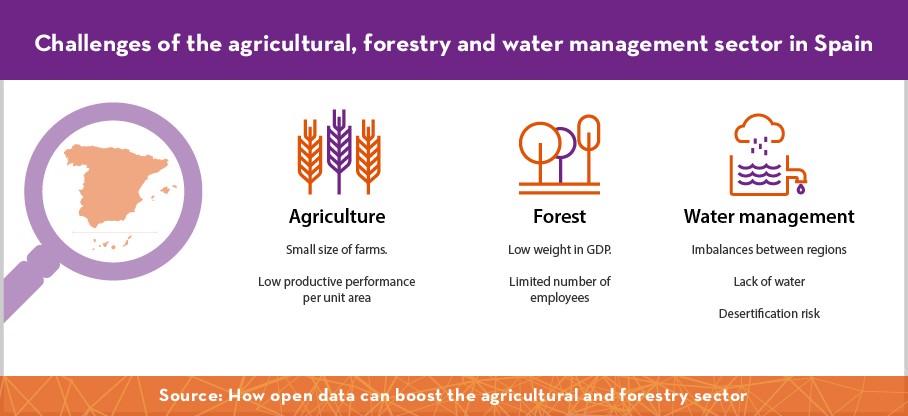
A few months ago we published a compilation of the main reports, studies, success stories and courses published by the Global Open Data for Agriculture and Nutrition (GODAN). This body seeks the proactive sharing of freely accessible data to make information on agriculture and nutrition available, accessible and usable.
To achieve this goal, GODAN has different teams that work in a coordinated manner for a common goal. One of them is the Capacity Development Work Group, focused on promoting open data knowledge (ongoing initiatives, innovations and good practices), as well as the development of new capacities. All of them to guarantee a more effective accessibility, use, engagement and understanding of open data.
In 2017, this group launched Godan webinar services, in order to offer a series of webinars organized in collaboration with the Technical Centre for Agricultural and Rural Co-operation (CTA). The videos, which last between 40 minutes and one hour, help to delve into different concepts: they explain how an open data initiative on agriculture should work, or how to tell stories with data to raise organizations and citizens’ awareness. Some of the organizations that have participated in the preparation of the contents are the Open Data Institute (ODI), Wageningen UR or The Land Portal Foundation, among others.
Here are some of the resources that can be found in Godan webinar services:
| Title | Content |
|---|---|
| Publishing open data from an organisational point of view | This webinar tries to answer a series of basic questions: Why is it necessary to publish open data? What benefit can publishing open data bring to the organization? Why are licenses important? How to start with publishing open data? |
| The Agriculture Open Data Package (AgPack) | In 2016, 4 agencies (GODAN, ODI, Open Data Charter and OD4D) developed the Agricultural Open Data Package (AgPack), which included 14 categories of datasets whose opening could have an important impact for the agricultural sector. This webinar shows detailed examples and use cases of governments that have achieved success in this area. |
| Effective data communication using data visualisations | Visualizations can help reveal, in a simple way, agriculture and nutrition trends to support decision making. This webinar explains the process of creating a good infographic, demonstrate some visualization software and reflects on how infographics are being applied for open data for agriculture and nutrition. |
| The Gender and Open Data Intersection | This webinar provides an analysis of open data from a gender perspective: from the current state of the question, to the challenges to overcome. The webinar ends with a series of recommendations to pave the way forward. |
| Agricultural Development: Role of Open Data in Ending Poverty | Open data can help end extreme poverty, end hunger and reduce inequalities. This webinar seeks to boost the capacity of states to openly share data and statistics for decision making. |
| Facilitating Standards and Impact Webinar | This webinar addresses the standards and impact evaluations of open data, with a special focus on weather data. Among other topics, the speakers analyse the trends and major gaps in the availability and use of weather data standards, followed by recommendations on how to make existing data standards more usable or how to develop services that facilitate the use of standards. All this through examples and success stories. |
| Farmers rights on data and ownership issues | Data ownership and privacy are two of the challenges of smart agriculture. This webinar tries to inform farmers about their rights from a legal perspective. |
| Unlocking the Potential of Blockchain for Agriculture | This webinar provides an overview of blockchain and analyzes its impact on agriculture, through examples and success stories in specific areas. The webinar also explains what capabilities people need to work with this technology. |
| Measuring the impact of open data initiatives in agriculture & nutrition | This webinar explains the methodology that GODAN uses to measure the impact of an open data initiative. Its evaluation framework focus on earlier stage assessment, as this offers better options to design new and, monitor and steer ongoing initiatives. |
In addition to these more general webinars, Godan webinar services also offers specific resources, where different initiatives tell their experience when publishing or reusing open data on agriculture and nutrition. An example is the Regional Centre for Mapping of Resources for Development (RCMRD), which shows some of the projects in which it is involved in one of the videos.
In short, whether you are a public body that wants to start or consolidate an open data initiatives on agriculture, or a reuser looking for examples and success stories to inspire you, Godan webinar services can provide resources and information of interest.
Why are open data important? What is their relationship with open government? How can I start an initiative of this kind? Who can I take as a reference? These are some of the questions that the Open Data Guide: Publication and reuse of Open Data as an initiative of Open Government in the Administration tries to answer
Prepared by the Ministry of Development and Environment of the Junta de Castilla y León, this guide is part of the Rural Digital Community (CRD), a collaboration project between Public Administrations of Portugal and Spain. The objective of the project is to improve the technological innovation of rural institutions, promoting cooperation and competitiveness.
The guide is divided into 5 sections: introduction to open data, current status of open government and open data, open data implementation , innovative solutions and success stories, and conclusions.
In the first introductory section, perfect for those unfamiliar with the open data world, some basic concepts are reviewed. The report focuses on open government as a sociopolitical mode of interaction based on 4 pillars - transparency, accountability, participation and collaboration - which can be promoted and improved thanks to open data. All this is explained in this section, which also describes the principles that data must meet to be considered open.
Next, the report address the current situation of open government and open data in Spain, Portugal and Europe, including existing regulations. In the case of Spain, the report highlights the existence of almost 300 initiatives, included in the initiatives map of datos.gob.es, as well as more than 660 companies that reuse information, with a business volume higher than 1,700 million euros per year. These data, together with the good position of Spain in the European Open Data Maturity Landscaping 2018 report, show the good momentum of open data in our country.
The third section of the report focuses on the implementation of open data in an organization. To facilitate this process, the authors of the guide have drawn up a plan with a series of stages that are detailed in the report:
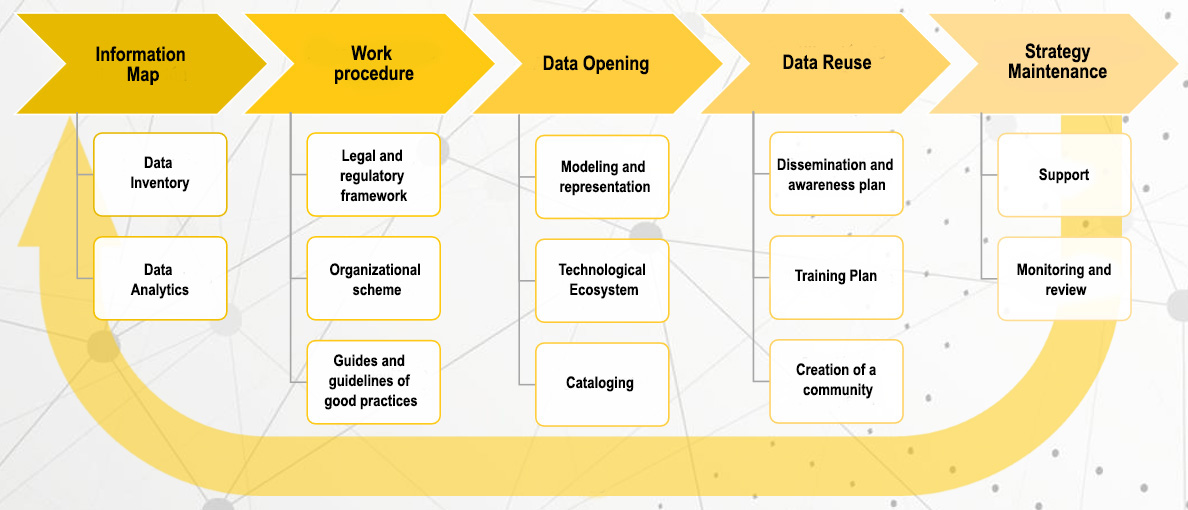
Finally, the report shows several examples of innovative solutions and success stories, based on 2 criteria:
- Examples of open data portals, which stand out for their functionality, such as Aragon Open Data or the download center of the National Geographic Institute (IGN), among others.
- Examples of good practices regarding reuse, due to their innovative nature and the economic or social value they generate. Examples of different sectors are included, such as real estate (TerceroB), meteorological (Meteogrid), public procurement (EuroAlert) or data journalism and public transparency (Civio).
The report concludes with a series of conclusions, such as the need to improve the training of both public employees who are immersed in data opening and companies and individuals to promote the use and analysis of data.
Below you can download the full report and delve into all of these sections.